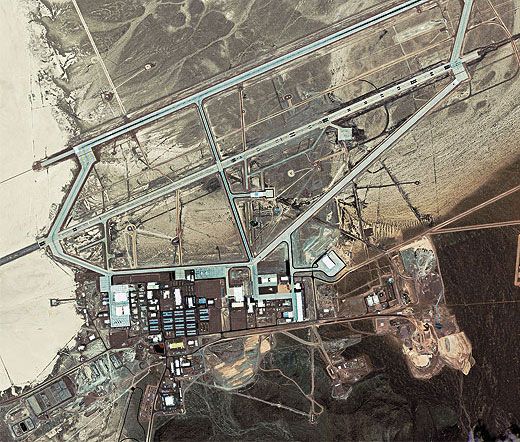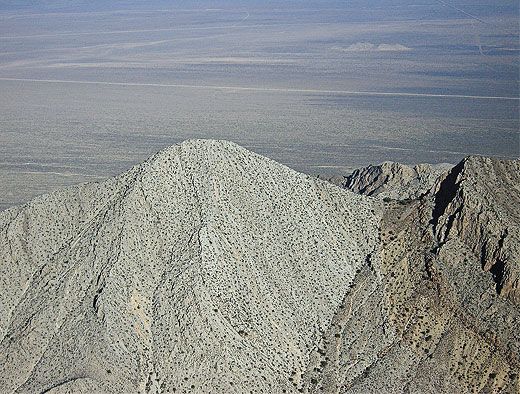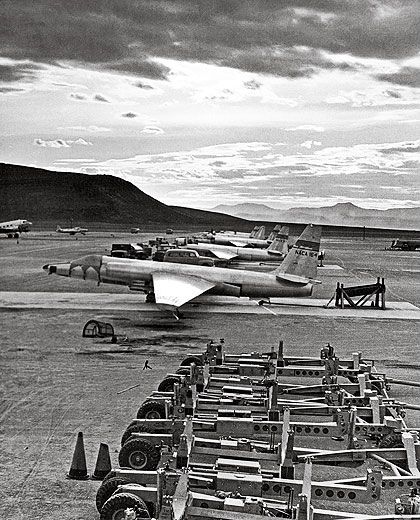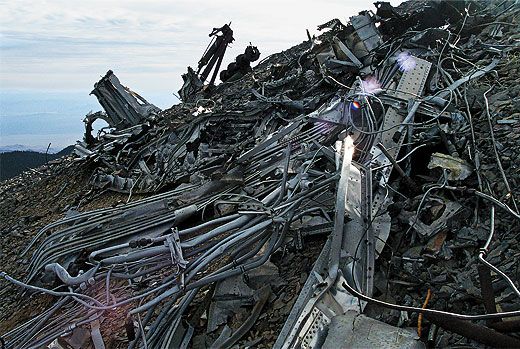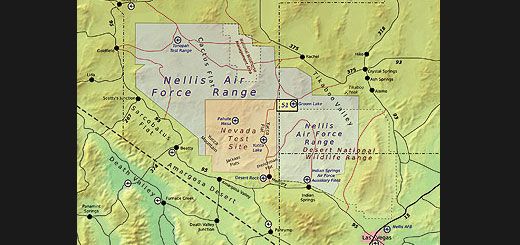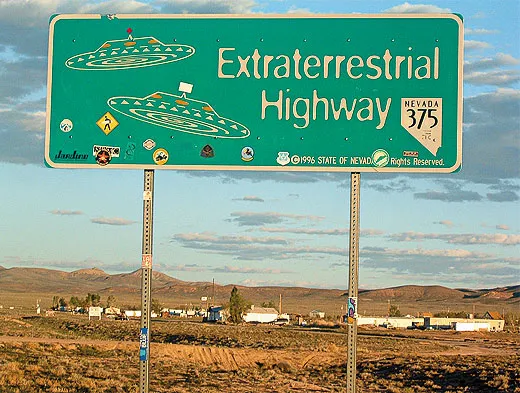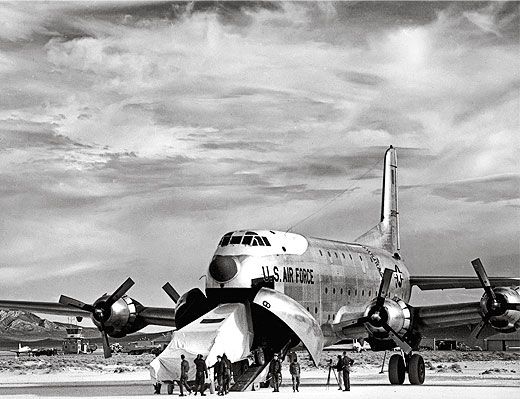The Truth is Out There
A veteran reporter describes his search for the aircraft of Area 51
/https://tf-cmsv2-smithsonianmag-media.s3.amazonaws.com/filer/The_truth_is_out_there_FLASH.jpg)
"And you'll see a very long runway right...there." Our aircraft commander jabbed a finger at a small, cross-hatched circle on the U.S. Air Force navigation chart. "But, even if we lose all four engines," he said, "we will not land on it.”
“Why not, sir?” I asked.
“We’d be there a long time and have to answer a lot of questions,” the commander replied, then moved on to the next day’s mission preview. A four-stripe sergeant leaned toward me. “That’s Groom Lake,” he said under his breath. “That’s where the really secret [stuff] happens.”
As a 22-year-old airman, I thought our outfit’s nuclear-sampling missions were mighty secret stuff. Not until the 1970s, when the Air Force Technical Applications Center’s mission was declassified, could we tell our families that we had routinely flown a variety of aircraft—from C-54s to B-52s—through radioactive clouds from U.S. and foreign bomb tests, collecting nuclear debris and gaseous samples (see “Into The Mushroom Cloud,” Aug. 2009). We wore plain black baseball caps and olive-drab flightsuits with no unit patches, and carried only the most basic identification. Whatever was going on at Groom Lake evidently was even more classified than our mission. I was impressed—and very curious.
That preflight briefing, at McClellan Air Force Base in California in the summer of 1969, was my introduction to one of the most secret aerospace development and testing sites in the world. Over the next 40 years, the Groom Lake mystery surfaced time and again, first in my role as a flight test engineer and later as a reporter for the magazine Aviation Week & Space Technology. But, like every other journalist chasing the story, I have yet to set foot on the alkaline dry lakebed with ultra-long runways, despite multiple requests to visit.
The secluded desert base, nestled along the rim of Groom Lake, about 80 miles north-northwest of Las Vegas, has been a test site for intriguing, cutting-edge aircraft since 1955. It has also been a breeding ground for rumors and conspiracy theories. Until the 1990s, the U.S. government wouldn’t even acknowledge that the place existed.
This black hole of military and intelligence-community secrecy is a product of the cold war, when the United States desperately needed to spy on Soviet bomber and missile developments. In the 1950s, when satellites capable of watching airfields, missile silos, and test sites across the Soviet Union were years away, the Central Intelligence Agency awarded Lockheed’s advanced development division, by then known as the Skunk Works, a contract to build what became the high-altitude, long-endurance U-2 spyplane. Designer Clarence “Kelly” Johnson directed Lockheed test pilot Tony LeVier to find an out-of-the-way airfield where the U-2 could be flight-tested. It had to be remote enough to prevent Soviet agents from spotting the black, long-winged airplane, yet reasonably close to Lockheed’s southern California engineering and aircraft production plants.
LeVier scoured the southwestern United States in a light aircraft, ultimately settling on a dry lakebed deep within the nation’s Nuclear Test Site complex in Nevada, which the Air Force had opened to the Atomic Energy Commission in 1950 to conduct nuclear weapons tests. In the summer of 1955, facilities were quickly built along the south shore of Groom Lake, and a few months later, U-2 test flights began. Johnson thought the infrastructure would be temporary, but over the next 50 years, new buildings and longer runways were built to accommodate development of numerous secret aircraft, including Lockheed’s SR-71 Blackbird, its A-12 and YF-12 cousins, the F-117 Nighthawk stealth fighter, and one-of-a-kind technology demonstrators. An impressive fleet of foreign fighters and attack aircraft—primarily Russian—also were collected at Groom Lake, flown, and evaluated by a group of test pilots and engineers known as the Red Hats.
In Johnson’s time, Lockheed workers called Groom Lake “the Ranch” or “Watertown Strip.” Flight test professionals at Edwards Air Force Base in California, which maintains a unit at Groom Lake called Detachment 3, referred to it as “the Site.” U.S. and foreign pilots participating in large-scale Red Flag exercises flown from Nellis Air Force Base in Nevada know Groom as “the Box,” a no-fly zone that often complicates the massive air-combat training scenarios. To most of the public, it’s simply “Area 51,” a reference to a numbered section on 1950s Atomic Energy Commission maps that divided the Nevada Test Site into grids.
SINCE 2005, Groom has undergone a robust burst of construction. The base now comprises numerous large hangars, dozens of worker dormitories, unusually long, paved runways, acres of concrete ramp space, recreation facilities, and even a watering hole called Sam’s Place, I learned from base employees. Groom watchers have spotted an enormous new hangar boasting an estimated 65,000 square feet, sheltered by a roof that at its peak soars to about 100 feet. Naturally, the expansion has fueled considerable speculation among enthusiasts who try to track Groom’s goings-on, especially the black-program aircraft based there. One of my sources at the Pentagon said the base’s current fleet is dominated by unmanned aerial vehicles like the Air Force’s RQ-170 Sentinel. Dubbed the “Beast of Kandahar” by U.S. troops in Afghanistan who have seen it, the stealthy Sentinel—a tailless flying wing built by Groom Lake’s first tenant, the Skunk Works—is tailored for tactical intelligence, surveillance, and reconnaissance missions to support combat troops. The Air Force confirmed the Sentinel’s existence in December 2009, but details about the gray, unarmed UAV—which was first spotted at Kandahar Airfield in late 2007—remain classified.
Although the federal government grudgingly acknowledges that the base does exist, Groom’s silence is still intact today, and its reputation for keeping secrets remains unblemished. Other intelligence units, such as the National Security Agency and the CIA, have suffered embarrassing security breaches over the years, but if any of Groom’s secrets have escaped, they didn’t make the news.
Such uncompromising secrecy can breed abuses. In the early 1990s, while I was researching Groom as a journalist, a former engineer from the base encouraged me to look into the amount of money being spent on the programs there. I devoted considerable time and effort to investigating those expenditures, but the black money trail proved almost impossible to follow. I did determine that the programs were then costing U.S. taxpayers between $30 and $36 billion a year—almost $100 million per day.
Far more productive were my interviews with dozens of people who reported seeing and hearing strange aircraft, mostly at night, primarily in the southwestern United States. Based on those and some of my own observations, I wrote about aircraft that produced unusual contrails and a deep, crackling roar described as “the sky ripping.”
Then, in the early 1990s, a CNN reporter faxed my magazine a sketch of an unusually large aircraft he had spotted flying over the Georgia countryside on a Sunday afternoon. Painted white, it closely resembled the retired North American XB-70 supersonic bomber. But there was something different: vertical tails positioned at the aircraft’s wingtips. (The vertical fins of the XB-70 were located inboard, closer to the fuselage centerline.) It couldn’t have been the XB-70 itself: The last one in existence was parked at the National Museum of the U.S. Air Force at Wright-Patterson Air Force Base in Dayton, Ohio.
Over the next few years, I collected half a dozen similar sketches, and all of them closely resembled the old bomber. Most eyewitness reports and sketches came from credible aerospace and military workers who were familiar with military aircraft. But calls also came from non-aerospace types. One particularly compelling report came from a witness who had seen the XB-70-like aircraft over her Pennsylvania home at very low altitude, less than 200 feet—so low, in fact, that she could tell the right-seat pilot was wearing a white helmet. The woman was an avid birdwatcher, and was pursuing a doctorate in immunology, so I considered her a legitimate witness: a seasoned scientist with good observational skills.
Typically, these sightings were accompanied by a distinctive, deep-throated, sometimes pulsing engine roar and unusual contrails described as “doughnuts on a rope”—spaced, puffy rings surrounding a thick rope of condensed exhaust—or segmented puffs, like a string of sausage links. I was able to obtain good photos of the contrails, and we published them, along with the eyewitness reports. However, proof that all these incidents were linked to a single aircraft or aircraft type continued to elude us.
At one point, an obscure reference to “Aurora” in a Department of Defense budget document fueled speculation in the media that a high-speed replacement for the SR-71 (which would be retired in 1998) was being developed or had already gone operational. We ultimately decided that Aurora was simply a cover name, a budget niche to hide money that the Pentagon was funneling to the Air Force’s classified B-2 Spirit bomber program.
In 1992, a series of intercepted radio transmissions presented an entirely new possibility for the mystery airplane. Around 6 a.m. Pacific time on April 5 and 22, Steve Douglass, an investigative journalist who monitors military aircraft radio chatter and maintains a black-projects blog (www.DeepBlueHorizon.blogspot.com), picked up transmissions between Edwards’ radar control facility and a high-altitude aircraft that was using the call sign “Gaspipe.” Controllers were directing the aircraft to a landing, using advisories that would be familiar to space shuttle astronauts returning from orbit. Edwards told Gaspipe: “You’re at sixty-seven thousand [feet], eighty-one miles out.” Moments later, Edwards radioed, “Seventy miles out, thirty-six thousand. Above glide slope.” During years of flight testing in the Edwards area, I had heard controllers issuing similar clipped directives. The cadence and tone of the one talking to Gaspipe were the same. I concluded that Douglass’ recording was authentic. The mystery aircraft was descending rapidly, dropping from an altitude of more than 12 miles to almost seven in a few seconds, and evidently it lined up to land. Where, we didn’t know. Maybe Groom Lake.
No fighter aircraft operated at such high altitudes, and my AvWeek colleagues and I quickly confirmed through NASA and the Air Force that no U-2s or SR-71s were airborne at those times. In followup calls, I was told the base’s radar approach control facility showed no record of controllers “working” an aircraft with the call sign Gaspipe on those dates.
I started wondering whether the spooks at Groom were flying a new spaceplane: a manned vehicle that could reach orbit, then return to land on a remote runway. My colleagues and I chased this mystery for more than a dozen years. In March 2006, we published a story about what was called the Blackstar two-stage-to-orbit system. We lacked proof, but had first-hand accounts from military pilots, technicians, and engineers of a small spaceplane, code-named the XOV—short for Experimental Orbital Vehicle—that was carried under the belly of an XB-70-like aircraft known as the SR-3. Earlier that year, a Groom insider had told me Blackstar had been shelved, because “it didn’t work out as well as we’d hoped.” Whether the problems were technical or financial, we may never know.
IN THE EARLY 1990s, when I was working from a home office in the high desert of southern California, about 45 miles from Edwards, I seemed to be at the center of spook-aircraft reports. The more stories we ran about black aircraft, the more reports we seemed to receive. Soon I was getting phone calls in the middle of the night from avid sky-watchers, urging me to “run outside and look to the north! The ‘pulser’ just flew over Mojave!” I never saw this particular aircraft, but I did hear its loud, pulsing signature a few times. In years in the flight test business, I had heard more than a few jet engines. This was something new.
Sightings were funneled my way, but other AvWeek reporters were also vetting the information. Trying to piece together dozens of observations, sketches, and a few photos, then deciphering what they meant, was like working on a 400-piece jigsaw puzzle with only 250 pieces. No matter how we shuffled the pieces, we could not be sure we had identified the full picture. Many of my sources refused to discuss black matters over the phone; their jobs and security clearances were at stake. And a law enforcement friend had confirmed that my home office phone line had a legal tap on it, from a court order in the 212 area code (New York City). I was never able to find out who had requested the tap or why. Consequently, my sources and I resorted to using codes. I’d call and ask a question such as “Are you helping with the silent auction at the kids’ school next week?” Translation: “I’ll meet you in the Gemco parking lot in 15 minutes.”
Several times my colleagues and I rented night-vision gear and set up makeshift observation sites near Edwards. Long nights of shivering in the desert, watching and listening, ultimately yielded one intriguing videotape: Our team saw and recorded what we called the “dripper,” a long, thin aircraft, cloaked in gold light, that appeared to shed luminescent clumps or pearl-like globs. I wasn’t with the team that night, but when I viewed the tape the next morning, I was just as puzzled and excited as those who had seen the dripper first-hand. I contacted physicists at the California Institute of Technology in Pasadena, who later watched the tape and decided our dripper’s shedding was “classic plasma bifurcation,” or the splitting of gas ions in the atmosphere. Fascinating, but why would an aircraft be shrouded in plasma? Was this a new type of stealth technology? If so, it must be of limited operational value, because at night, the aircraft, visible for miles, failed miserably at visual stealth.
We had data and some intriguing theories but no confirmation. However, much of what we did have seemed to point to one place: Groom Lake. It was time to join the cadre of watchers who prowled the borders of this enigmatic Mecca of advanced aircraft. In the mid-1990s, the federal government extended the borders of the restricted areas around Groom, removing almost 4,000 acres of land from public access. The base’s facilities could be seen clearly from only a few mountains and ridge lines, and the move prevented anybody climbing them. The one remaining viewing site was Tikaboo Peak, about 30 miles from the base. Those who had made the difficult climb told me they couldn’t see much of interest.
Under time and budget constraints, I opted to drive from Las Vegas and simply park just off Highway 375, northeast of Groom. The base was miles away, hidden behind rugged mountains, but that’s about as close as any outsider could get.
I had perused an old Air Force Security Police manual entitled Det 3 SP—Job Knowledge, which included rudimentary drawings and descriptions of field sensors—motion, acoustic, and other types—scattered around Groom. According to the manual, these battery-powered canisters were buried with their “flat end facing the roadway,” enabling them to detect passing vehicles and set off alarms if anybody got close to the base.
I couldn’t monitor activity at the base itself, but maybe I’d spot the sky-ripper departing for a late-night test flight. A near-full moon provided enough light to reveal an aircraft, if one were to take off that night. Hours went by, the moon climbed higher, but I saw nothing. The desert was dead quiet, and downright lonely. Around 2 a.m., fighting to stay awake, I suddenly felt the rental car rocking back and forth. I bolted upright. A short-horn steer was using the car’s left-rear corner as a scratching post. About a dozen open-range cattle were clustered around the car, probably wondering why I had intruded on their pasture.
By 4 a.m., having seen or heard nothing departing Groom, I headed for a motel. Joining me the next night was a Las Vegas TV crew that was equipped with night-vision gear and a portable radio-frequency scanner. We had barely settled in for the evening when the scanner blared: “[Call sign], do you have the four-wheeler down by the mailbox?”
“Yeah. I got him,” came a bored reply.
Across the highway from us stood a local rancher’s black, post-mounted mailbox. The four-wheeler under discussion was ours. We hadn’t been there a half-hour, and the “camo dudes”—what black-aircraft watchers call the camouflage-uniformed Groom guards— were already on to us. Maybe the presence of two reporters and a TV cameraman prompted the base’s commander to cancel that night’s tests. Or maybe Groom test pilots don’t fly on nights when the moon is full and bright. For whatever reason, we saw nothing more exciting that night than lightning flashes from a distant thunderstorm.
WHILE EMPLOYEES AT THE BASE won’t talk about classified aircraft or technologies, some have offered tidbits about what it’s like to work there. Many of the workers live in the Las Vegas area and are flown to Groom on Boeing 737s. These aircraft, painted white with a nose-to-tail red stripe, ferry people and supplies to and from the base. Typically, workers fly to Groom on a Monday and back to Las Vegas on Thursday or Friday, although daily roundtrip flights are common.
Test pilots, managers, engineers, technicians, mechanics, and support personnel stay in base dormitories, which may have been upgraded in recent years. In the 1980s and 1990s, Groom’s pilots lived in “old wooden World War II barracks with creaky floors,” one told me. Each pilot had his own eight- by eight-foot room, which boasted a single window—painted shut. Test personnel typically worked 14-hour days, almost exclusively at night. The base closely monitored satellite overflights—“both ours and theirs,” one Groom engineer said. Test flights were scheduled to preclude a secret aircraft being photographed from space. As more countries launched military satellites and commercial imaging spacecraft proliferated, it became increasingly difficult to conduct flight tests in secrecy.
“Sometimes we’d barely get airborne, when we’d have to land to avoid a [satellite] overflight,” one pilot told me. “Scoot shelters,” portable carport-like structures, were positioned on the ramp to hide an aircraft until the satellite was out of range. Eventually, shelters were also positioned at remote airfields throughout the Nellis and adjacent Utah test and training ranges, for pilots who couldn’t get back to Groom before a satellite topped the horizon.
Avoiding detection by satellites produced one innovation that also greatly improved flight test efficiency. Rather than land at Groom or another strip, pilots simply flew their aircraft beneath a KC-135 or -10 refueling tanker, shielding them from the satellites. Not only could a tanker serve as an airborne scoot shelter, it could refuel test aircraft as well, enabling more test points on a single sortie.
Groom Lake has also been rumored to hide captured alien spacecraft and their big-eyed, little gray-guy crews. Those convinced that unidentified flying objects come from other worlds are just as convinced that some are hidden in Groom’s hangars. I’ve never seen anything to support that notion.
However, it’s clear to me that the UFO phenomenon is used to protect the base’s deepest secrets. I once was advised that if I wanted clues about real-world classified aircraft projects, I should read the supermarket tabloids. If a hiker spotted a new airplane during a test flight near Groom and talked about it openly, the story might appear in one of the tabloids—although wrapped in a wild tale, complete with grainy photos of flying saucers and alien beings. I once asked a Groom test pilot whether tainting classified-aircraft sightings with the UFO stench was ever done intentionally. He smiled and replied: “It’s worked for 50 years. Why would we change now?” Without question, black-world operators have become masters of such deception to protect their work. As a result, Groom Lake will likely retain its secrets for a very long time.
William B. Scott is co-author of the novel Counterspace: The Next Hours of World War III.
